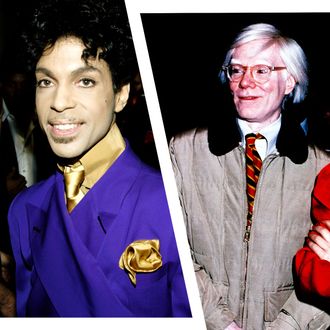|
Supreme Court Rules Warhol’s Prince Portrait Isn’t Diff-print Enough

The Supreme Court has decided that photographer Lynn Goldsmith’s prints are all over Andy Warhol’s art, ruling on May 18 that Warhol’s portrait of the Artist Formerly Known as Prince infringed on fair-use copyright laws. Warhol made his version in 1984, and it was based on a portrait of Prince done by Goldsmith. The case hinged on whether this re-creation violated fair use by using Goldsmith’s work for commercial purposes. Ultimately, the court decided in a 7-2 decision that fair use was, in fact, violated. In 2016, the Andy Warhol Foundation for the Visual Arts licensed the Warhol portrait to Condé Nast for the cover of a magazine commemorating Prince without Goldsmith’s permission — despite the fact that Goldsmith had initially granted Vanity Fair only a onetime license in 1984 to use her work as a “source photograph.”
“An overbroad concept of transformative use, one that includes any further purpose, or any different character, would narrow the copyright owner’s exclusive right to create derivative works,” Justice Sonia Sotomayor wrote in the opinion of the court. “To preserve that right, the degree of transformation required to make ‘transformative’ use of an original must go beyond that required to qualify as a derivative.”
Justice Elena Kagan dissented, stating that fair use’s primary test factor “provides ‘breathing space’ for artists to use existing materials to make fundamentally new works, for the public’s enjoyment and benefit,” adding that “in now remaking that factor, and thus constricting fair use’s boundaries, the majority hampers creative progress and undermines creative freedom.”
Supreme Court Rules Against Andy Warhol in Copyright Case
The justices considered whether the artist was free to use elements of a rock photographer’s portrait of the musician Prince.

Reporting from Washington
The Supreme Court ruled on Thursday that Andy Warhol was not entitled to draw on a prominent photographer’s portrait of Prince for an image of the musician that his estate licensed to a magazine, limiting the scope of the fair-use defense to copyright infringement in the realm of visual art.
The vote was 7 to 2. Justice Sonia Sotomayor, writing for the majority, said the photographer’s “original works, like those of other photographers, are entitled to copyright protection, even against famous artists.”
She focused on the fact that Warhol and Lynn Goldsmith, the photographer whose work he altered, were both engaged in the commercial enterprise of licensing images of Prince to magazines.
“To hold otherwise would potentially authorize a range of commercial copying of photographs, to be used for purposes that are substantially the same as those of the originals,” Justice Sotomayor wrote. “As long as the user somehow portrays the subject of the photograph differently, he could make modest alterations to the original, sell it to an outlet to accompany a story about the subject, and claim transformative use.”
In dissent, Justice Elena Kagan, joined by Chief Justice John G. Roberts Jr., wrote that the decision “will stifle creativity of every sort.”
“It will impede new art and music and literature,” she wrote. “It will thwart the expression of new ideas and the attainment of new knowledge. It will make our world poorer.”
- Thanks for reading The Times.
The dueling opinions, from two liberal justices who are often allies, had an unusually sharp tone.
Justice Kagan’s opinion, Justice Sotomayor wrote, was made up of “a series of misstatements and exaggerations, from the dissent’s very first sentence to its very last.”
Recent U.S. Supreme Court Decisions
- Internet Liability Shield: The Supreme Court said that it would not rule on the scope of Section 230, a federal law that shields internet platforms from legal responsibility for what their users post.
- Copyright: The Supreme Court ruled that Andy Warhol was not entitled to draw on a prominent photographer’s portrait of Prince for a series of images of the musician, limiting the scope of the fair-use defense to copyright infringement in the realm of visual art.
- Gun Control: The justices refused to block two Illinois laws prohibiting the sale of high-powered guns and high-capacity magazines while other challenges to them move forward..
Justice Kagan responded that Justice Sotomayor wholly failed to appreciate Warhol’s art.
“The majority does not see it,” Justice Kagan wrote. “And I mean that literally. There is precious little evidence in today’s opinion that the majority has actually looked at these images, much less that it has engaged with expert views of their aesthetics and meaning.”
The decision was also unusual for including more than a dozen reproductions of artworks by Warhol and others, most of them in color.
The portrait of Prince at issue in the case was taken in 1981 by Lynn Goldsmith, a successful rock photographer on assignment for Newsweek.
In 1984, around the time Prince released “Purple Rain,” Vanity Fair hired Warhol to create a work to accompany an article titled “Purple Fame.” The magazine paid Ms. Goldsmith $400 to license the portrait as an “artist reference,” agreeing to credit her and to use it only in connection with a single issue.
In a series of 16 images, Warhol altered the photograph in various ways, notably by cropping and coloring it to create what his foundation’s lawyers described as “a flat, impersonal, disembodied, mask-like appearance.” Vanity Fair ran one of them.
Warhol died in 1987, and the Andy Warhol Foundation for the Visual Arts assumed ownership of his work. When Prince died in 2016, Vanity Fair’s parent company, Condé Nast, published a special issue celebrating his life. It paid the foundation $10,250 to use a different image from the series for the cover. Ms. Goldsmith received no money or credit.

Litigation followed, much of it focused on whether Warhol had transformed Ms. Goldsmith’s photograph. The Supreme Court has said a work is transformative if it “adds something new, with a further purpose or different character, altering the first with new expression, meaning or message.”
Justice Kagan rejected the idea that those photographs and Warhol’s image were fungible.
“Suppose you were the editor of Vanity Fair or Condé Nast, publishing an article about Prince,” she wrote. “You need, of course, some kind of picture. An employee comes to you with two options: the Goldsmith photo, the Warhol portrait. Would you say that you don’t really care? That the employee is free to flip a coin? In the majority’s view, you apparently would.”
She added: “All I can say is that it’s a good thing the majority isn’t in the magazine business. Of course you would care!”
The majority’s analysis, Justice Kagan wrote, was simplistic and wooden.
“All of Warhol’s artistry and social commentary,” she wrote, “is negated by one thing: Warhol licensed his portrait to a magazine, and Goldsmith sometimes licensed her photos to magazines too. That is the sum and substance of the majority opinion.”
The case, Andy Warhol Foundation for the Visual Arts v. Goldsmith, No. 21-869, concerned the limits of the fair-use defense, which allows copying that would otherwise be unlawful if it involves activities like criticism and news reporting.
Lower courts differed about whether Warhol’s alterations of the photograph transformed it into something different. Judge John G. Koeltl of the Federal District Court in Manhattan ruled that Warhol had created something new by imbuing the photograph with fresh meaning.
But a three-judge panel of the U.S. Court of Appeals for the Second Circuit said that judges should compare how similar the two works are and leave the interpretation of their meaning to others.
“The district judge should not assume the role of art critic and seek to ascertain the intent behind or meaning of the works at issue,” Judge Gerard E. Lynch wrote for the panel. “That is so both because judges are typically unsuited to make aesthetic judgments and because such perceptions are inherently subjective.”
Justice Sotomayor wrote that a crucial factor in the fair-use analysis — “the purpose and character of the use, including whether such use is of a commercial nature or is for nonprofit educational purposes” — weighed in Ms. Goldsmith’s favor.
“Warhol himself paid to license photographs for some of his artistic renditions,” Justice Sotomayor wrote. “Such licenses, for photographs or derivatives of them, are how photographers like Goldsmith make a living. They provide an economic incentive to create original works, which is the goal of copyright.”
Other Warhol works, like Warhol’s images of Campbell’s soup cans, were a different matter, she wrote.
“The purpose of Campbell’s logo is to advertise soup. Warhol’s canvases do not share that purpose,” Justice Sotomayor wrote. “Rather, the soup cans series uses Campbell’s copyrighted work for an artistic commentary on consumerism.”
Adam Liptak covers the Supreme Court and writes Sidebar, a column on legal developments. A graduate of Yale Law School, he practiced law for 14 years before joining The Times in 2002. @adamliptak • Facebook









